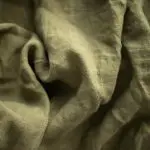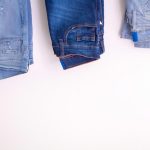Caring for your Pima cotton garments is essential to maintaining their soft texture and vibrant colors. You'll want to wash them in cold or lukewarm water with a gentle detergent, steering clear of bleach and fabric softeners. Once washed, air drying is preferable, but if you must use a dryer, keep it on low heat. Ironing requires some attention too, especially when it comes to temperature. But there's more to ensuring the longevity of your favorite pieces, especially when it comes to storage and stain management. What's the best approach to tackle those inevitable mishaps?
Table of Contents
Understanding Pima Cotton
Pima cotton is a premium fiber known for its softness, durability, and luxurious feel, making it a popular choice for high-quality garments. When you choose Pima cotton, you're investing in a fabric that stands out for its long, silky fibers. These fibers not only enhance the softness but also contribute to the fabric's remarkable strength and resistance to fraying.
You'll appreciate how Pima cotton holds color exceptionally well, giving your clothes a vibrant appearance that lasts through countless wears. Unlike regular cotton, Pima is less prone to fading, making your investment worthwhile. Its breathability ensures comfort in various climates, keeping you cool in the heat and warm in cooler temperatures.
As you wear Pima cotton garments, you'll notice they maintain their shape and don't wrinkle easily, so you can look polished with minimal effort. This fabric is also hypoallergenic, making it suitable for those with sensitive skin.
Washing Your Pima Cotton
When washing your Pima cotton garments, it's important to use the right temperature to maintain their softness and durability.
You'll also want to choose a gentle detergent that won't harm the fabric's natural fibers.
Let's explore the best practices for keeping your Pima cotton looking great.
Ideal Washing Temperature
Washing your Pima cotton garments at a cool temperature helps maintain their softness and vibrant color. Ideally, you should set your washing machine to a cold or lukewarm cycle, around 30°C (86°F). This temperature is gentle enough to protect the delicate fibers while effectively cleaning your clothes. Hot water can cause Pima cotton to lose its luster and lead to shrinkage, so it's best to avoid it.
When you wash your Pima cotton items, ensure that you separate them from heavier fabrics, like towels or denim. Mixing these with your Pima cotton can create friction that may damage the fibers. If you have multiple colors, washing similar shades together prevents color bleeding.
If your garment has stubborn stains, consider treating them before washing, but steer clear of soaking in hot water. After washing, you can either line dry your Pima cotton or tumble dry on a low heat setting.
Detergent Recommendations
Choosing the right detergent is crucial for preserving the quality of your Pima cotton garments. You'll want to opt for a gentle, liquid detergent that's free of harsh chemicals and brighteners. These additives can deteriorate the fibers and affect the fabric's natural sheen. Look for a detergent specifically designed for delicate fabrics or one labeled as suitable for cotton.
When washing your Pima cotton items, avoid using bleach or fabric softeners. Bleach can weaken the fibers, while fabric softeners can create a residue that impacts breathability. Instead, consider adding a cup of white vinegar during the rinse cycle. It acts as a natural fabric softener and helps maintain the softness of the cotton.
For best results, always follow the care instructions on the garment label. This ensures that you're using the right amount of detergent and washing at the optimal temperature. If you're dealing with stubborn stains, pre-treat them with a small amount of detergent before washing. Gently rub the fabric together, then let it sit for about 15 minutes.
Drying Techniques
To maintain your Pima cotton garments' softness and durability, opt for air drying whenever possible. Hang your clothes on a drying rack or a clothesline in a shaded area to protect them from direct sunlight, which can fade colors and weaken fibers. If you're in a hurry, you can also lay them flat on a clean, dry towel.
If you must use a dryer, choose a low or medium heat setting. High heat can cause Pima cotton to shrink or lose its softness. To further protect your garments, consider placing them in a mesh laundry bag. This extra layer helps prevent snagging and damage during the drying process.
Avoid using dryer sheets, as they can leave a residue that impacts the fabric's breathability. Instead, you might want to try a few dryer balls, which can help improve airflow and reduce drying time without the chemicals.
Once your clothes are dry, don't leave them in the dryer for too long. Remove them promptly to minimize wrinkles and maintain that lovely, soft feel.
Following these drying techniques will ensure your Pima cotton garments stay in excellent condition for years to come.
Ironing and Steaming
When it comes to keeping your Pima cotton garments looking their best, proper ironing techniques are essential.
You might wonder whether to steam or iron, as both methods have their advantages.
Let's explore some fabric care tips to ensure your clothes stay smooth and stylish.
Proper Ironing Techniques
Ironing Pima cotton garments requires careful attention to temperature and technique to maintain their softness and sheen.
Start by setting your iron to a medium heat setting, ideally around 350°F (175°C). Always check the care label on your garment before you begin, as some variations may require different temperatures.
Before you start ironing, make sure the fabric is slightly damp. If it's dry, lightly mist it with water or use a steam function on your iron. This helps to ease out wrinkles without excessive heat, which can damage the fibers.
When you're ready to iron, work on the inside of the garment whenever possible. This protects the outer layer and keeps that beautiful sheen intact.
Use smooth, even strokes, and don't let the iron sit in one spot for too long to avoid scorching. For tricky areas like collars and cuffs, you might want to use the tip of the iron for precision.
Steaming Vs. Ironing
Steaming offers a gentler alternative to ironing, making it ideal for refreshing Pima cotton garments without risking damage to the fibers. When you use a steamer, the hot steam relaxes the fabric, helping to release wrinkles without direct contact. This method minimizes the risk of scorching or creating shiny spots on your garment, which can happen with traditional ironing.
On the other hand, ironing can be effective for achieving a crisp finish, but it requires careful attention. If you choose to iron, always use a low to medium heat setting and place a cloth between the iron and the fabric. This ensures you won't burn the fibers. However, keep in mind that repeated ironing might lead to a loss of softness over time.
Ultimately, the choice between steaming and ironing comes down to your personal preference. If you're looking for a quick refresh, steaming is the way to go. If you want a more polished look, ironing can do the trick—just be cautious.
Whichever method you choose, treating your Pima cotton with care will help maintain its beautiful quality for years to come.
Fabric Care Tips
Taking care of your Pima cotton garments involves knowing the best practices for both ironing and steaming to keep them looking their best.
When ironing, always check the care label first. Set your iron to a medium heat and use steam if necessary. It's best to iron your garment while it's slightly damp; this makes it easier to remove wrinkles without damaging the fabric. Always iron on the reverse side to avoid any shine on the surface.
If you prefer steaming, it's a gentle alternative that can refresh your Pima cotton without direct contact. Hang your garment on a sturdy hanger and use a steamer to eliminate wrinkles. Keep the steamer nozzle a few inches away from the fabric to prevent moisture buildup, which can lead to water spots. Move the steamer in a downward motion, allowing the steam to penetrate the fibers.
In both methods, avoid excessive heat and pressure, as these can harm the natural fibers. Regularly caring for your Pima cotton garments won't only keep them wrinkle-free but also extend their lifespan, ensuring you enjoy them for years to come.
Storing Your Garments
How can you ensure your Pima cotton garments stay in top condition while stored? Proper storage is essential to maintaining their softness and durability. First, make sure your garments are clean and completely dry before storing them. Fold your clothes neatly to avoid creases, and store them in a cool, dry place away from direct sunlight.
Here's a quick guide to help you:
| Storage Method | Pros | Cons |
|---|---|---|
| Folding | Saves space | Can cause creases |
| Hanging | Keeps shape | Requires more space |
| Rolling | Reduces wrinkles | May not fit all closets |
You might also consider using breathable garment bags to protect your Pima cotton from dust and pests. Avoid plastic bags, as they can trap moisture and lead to mildew. If you're stacking folded garments, place heavier items on the bottom and lighter ones on top to avoid unnecessary pressure. Lastly, check on your stored items periodically to ensure they remain in excellent condition. Following these tips will help keep your Pima cotton garments looking and feeling great for years to come!
Dealing With Stains
Even with proper storage, stains can happen, so knowing how to treat them quickly is vital for preserving your Pima cotton garments. When you notice a stain, act fast. The longer you wait, the harder it'll be to remove.
Start by gently blotting the stain with a clean cloth to absorb any excess liquid, but don't rub it; that could make things worse.
Next, rinse the area with cold water. This helps to loosen the stain. After rinsing, you can apply a mild detergent directly to the stain. Let it sit for about 5-10 minutes before rinsing again. If the stain persists, consider using a specialized stain remover made for delicate fabrics.
To keep your Pima cotton looking its best, remember these tips:
- Always test stain removers on a hidden area first.
- Avoid using bleach, as it can weaken the fibers.
Frequently Asked Questions
What Is the Origin of Pima Cotton?
Pima cotton originates from the United States, specifically developed in the early 1900s. It's a premium variety of cotton, known for its long fibers, which provide exceptional softness and durability, making it highly sought after.
Is Pima Cotton Eco-Friendly?
Yes, pima cotton can be eco-friendly. It's often grown using sustainable practices, reducing water and pesticide usage. When you choose pima, you're supporting a more environmentally friendly textile option that benefits both you and the planet.
Can I Wear Pima Cotton in Hot Weather?
Yes, you can wear Pima cotton in hot weather! Its breathable and lightweight nature helps keep you cool, making it a great choice for summer outfits. You'll enjoy comfort and style while staying relaxed during warm days.
How Does Pima Cotton Compare to Regular Cotton?
Pima cotton's softer and more durable than regular cotton, making it ideal for comfort and longevity. Its long fibers resist fraying and fading, so you'll enjoy a luxurious feel that lasts much longer.
Can Pima Cotton Garments Shrink?
Yes, Pima cotton garments can shrink if exposed to high heat during washing or drying. To minimize shrinking, you should wash them in cold water and air dry or use low heat settings.
- Ramie vs. Linen: Comparing Two Bast Fiber Breathability Stars - June 5, 2025
- Ramie vs. Linen: Comparing Two Bast Fiber Breathability Stars - June 5, 2025
- Ramie vs. Linen: Comparing Two Bast Fiber Breathability Stars - June 5, 2025







